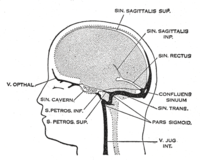
Photo from wikipedia
Objectives: There is a higher prevalence of cerebral venous sinus thrombosis (CVST) in more recent times, owing to increased awareness, clinical diagnostic skills, and advancements in neuroimaging modalities. This study… Click to show full abstract
Objectives: There is a higher prevalence of cerebral venous sinus thrombosis (CVST) in more recent times, owing to increased awareness, clinical diagnostic skills, and advancements in neuroimaging modalities. This study aimed to identify and characterize the geographical, clinical, and etiological profiles of patients with CVST that may be relevant to planning appropriate diagnostic and therapeutic strategies to improve functional recovery. Methods and Results: A retrospective observational study was carried out at a tertiary care hospital between March 2014 and October 2018. The demographics and clinical profile of the hospitalized patients were extracted from the Medical Record Division. Choropleth maps were created to present the geographic distribution of the patients with CVST admitted to our hospital. A total of 145 patients with CVST were included in the study. Etiological factors revealed striking abnormalities in red blood cells counts and serum homocysteine. Analyzing the geographical distribution of the patients with CVST showed most of the patients hailed from Central Karnataka Plateau 106 (73%). Polycythemia was most commonly seen in patients residing in the Central Karnataka Plateau 21 (62%). Conclusion: It is inferred that large scale community-based studies to identify a genetic abnormality like a mutant erythropoietin gene should be undertaken to plan effective diagnostic, therapeutic, and preventive measures.
Journal Title: Annals of Indian Academy of Neurology
Year Published: 2022
Link to full text (if available)
Share on Social Media: Sign Up to like & get
recommendations!